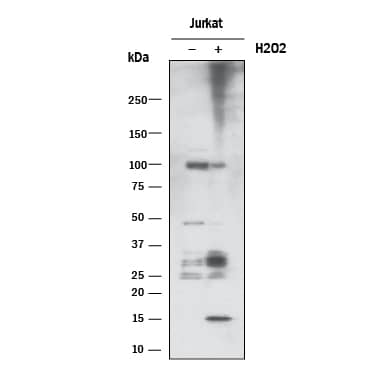Human LKB1/STK11 Antibody Summary
Met1-Gln433
Accession # Q15831
Customers also Viewed
Applications
Please Note: Optimal dilutions should be determined by each laboratory for each application. General Protocols are available in the Technical Information section on our website.
Scientific Data
 View Larger
View Larger
Detection of Human LKB1/STK11 by Western Blot. Western blot shows lysates of MCF-7 human breast cancer cell line and K562 human chronic myelogenous leukemia cell line. PVDF membrane was probed with 2 µg/mL of Sheep Anti-Human LKB1/STK11 Antigen Affinity-purified Polyclonal Antibody (Catalog # AF8055) followed by HRP-conjugated Anti-Sheep IgG Secondary Antibody (Catalog # HAF016). A specific band was detected for LKB1/STK11 at approximately 55 kDa (as indicated). This experiment was conducted under reducing conditions and using Immunoblot Buffer Group 1.
 View Larger
View Larger
LKB1/STK11 in Human Breast Cancer Tissue. LKB1/STK11 was detected in formalin fixed paraffin-embedded sections of human breast cancer tissue using Sheep Anti-Human LKB1/STK11 Antigen Affinity-purified Polyclonal Antibody (Catalog # AF8055) at 1 µg/mL overnight at 4 °C. Before incubation with the primary antibody, tissue was subjected to heat-induced epitope retrieval using Antigen Retrieval Reagent-Basic (Catalog # CTS013). Tissue was stained using the Anti-Sheep HRP-DAB Cell & Tissue Staining Kit (brown; Catalog # CTS019) and counterstained with hematoxylin (blue). Specific staining was localized to tumor cell nuclei. View our protocol for Chromogenic IHC Staining of Paraffin-embedded Tissue Sections.
 View Larger
View Larger
LKB1/STK11 in Human Breast. LKB1/STK11 was detected in formalin fixed paraffin-embedded sections of human breast tissue using Sheep Anti-Human LKB1/STK11 Antigen Affinity-purified Polyclonal Antibody (Catalog # AF8055) at 10 µg/mL overnight at 4 °C. Before incubation with the primary antibody, tissue was subjected to heat-induced epitope retrieval using Antigen Retrieval Reagent-Basic (Catalog # CTS013). Tissue was stained using the Anti-Sheep HRP-DAB Cell & Tissue Staining Kit (brown; Catalog # CTS019) and counterstained with hematoxylin (blue). Specific staining was localized to the cytoplasm and nuclei. View our protocol for Chromogenic IHC Staining of Paraffin-embedded Tissue Sections.
 View Larger
View Larger
Western Blot Shows Human LKB1/STK11 Specificity by Using Knockout Cell Line. Western blot shows lysates of HEK293T human embryonic kidney parental cell line and LKB1/STK11 knockout HEK293T cell line (KO). PVDF membrane was probed with 2 µg/mL of Sheep Anti-Human LKB1/STK11 Antigen Affinity-purified Polyclonal Antibody (Catalog # AF8055) followed by HRP-conjugated Anti-Sheep IgG Secondary Antibody (Catalog # HAF016). A specific band was detected for LKB1/STK11 at approximately 54 kDa (as indicated) in the parental HEK293T cell line, but is not detectable in knockout HEK293T cell line. GAPDH (Catalog # AF5718) is shown as a loading control. This experiment was conducted under reducing conditions and using Immunoblot Buffer Group 1.
Preparation and Storage
- 12 months from date of receipt, -20 to -70 °C as supplied.
- 1 month, 2 to 8 °C under sterile conditions after reconstitution.
- 6 months, -20 to -70 °C under sterile conditions after reconstitution.
Background: LKB1/STK11
LKB1 (Liver kinase B1; also STK11/Ser/Thr-protein kinase 11 and NY-REN19) is a 55 kDa intracellular member of the LKB1 subfamily, CAMK Ser/Thr protein kinase family of molecules. It is widely expressed, being particularly investigated in small intestinal columnar epithelium and hepatocytes. STK11 is associated with a wide variety of functions, including the initiation of apoptosis through binding to p53, the regulation of TGF-beta signaling through the creation of a SMAD4-LIP1-STK11 complex, and the generation of an epithelial polarized phenotype via cytoskeletal remodeling. Schematically, it would appear that STK11 acts, at least in part, through its ability to phosphorylate multiple AMPK-related kinases, as well as AMPK itself. Human STK11 is 433 amino acids (aa) in length. It potentially contains a three aa propeptide at its C-terminus. The mature segment (aa 1-430) possesses one large protein kinase domain (aa 49-309) plus at least four utilized phosphorylation sites. Phosphorylation on Ser428 promotes the ability of LKB1 to suppress G361 cell growth. Palmitoylation is suggested to occur on Cys418. There are three alternative splice variants. Either individually or in combination, they involve an insertion of nine aa after Tyr126 and a 34 aa substitution for aa 371-433. Full-length human STK11 shares 90% aa sequence identity with mouse STK11.
Product Datasheets
FAQs
No product specific FAQs exist for this product, however you may
View all Antibody FAQsIsotype Controls
Reconstitution Buffers
Secondary Antibodies
Reviews for Human LKB1/STK11 Antibody
There are currently no reviews for this product. Be the first to review Human LKB1/STK11 Antibody and earn rewards!
Have you used Human LKB1/STK11 Antibody?
Submit a review and receive an Amazon gift card.
$25/€18/£15/$25CAN/¥75 Yuan/¥2500 Yen for a review with an image
$10/€7/£6/$10 CAD/¥70 Yuan/¥1110 Yen for a review without an image


















